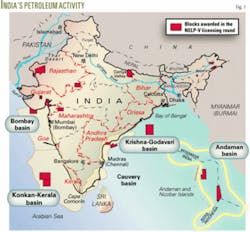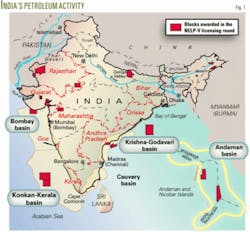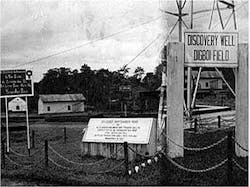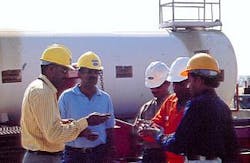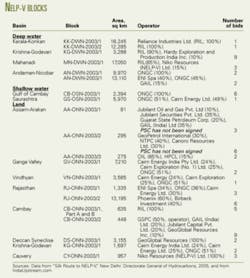Local demand for natural gas, a string of moderate successes, and improvements in the regulatory environment are driving drilling operations in India.
Two of the largest finds in India in the last few years are Reliance Industries Ltd.’s deepwater gas discovery in the Krishna-Godavari (K-G) basin in October 2002 and Cairn Energy Ltd.’s gas and oil discoveries in Rajasthan in 2004-05 (Fig. 1).
Oil and Natural Gas Corp. Ltd. (ONGC) is the largest and most active operator. The second-largest national company working domestically upstream is Oil India Ltd.
ONGC
In December, ONGC had 30 offshore rigs drilling (24 jack ups, 5 drillships, 1 drilling barge) and 1 platform rig engaged in a workover off India.
Subir Raha, ONGC’s chairman and managing director, told OGJ that the company’s Sagar Samriddhi (“prosperity through the oceans”) deepwater drilling campaign is currently employing three deepwater drillships at $1 million/day under long-term contracts. He said that the deepwater rigs would cost $2 million/day at current market rates and that there were no plans to add more deepwater rigs. There are 47 deepwater wells budgeted and 29 of them will be drilled in this first phase: 11 by the Belford Dolphin, 12 by the Discoverer Seven Seas ($315,000/day), and 6 by the Sagar Vijay.
There are 13 survey vessels working for ONGC on both coasts. Before the 2005 monsoon season, 6,000 people and 300 vessels were working offshore, with no reported lost-time accidents. Raha pointed out that deepwater drilling is a “high-cost, high-risk process.”
On Dec. 5, 2005, ONGC published a tender for 11 offshore drilling rigs (3-yr contract). Pre-bid conferences will be held Jan. 27 and Feb. 7, 2006, in Mumbai. ONGC wants 9 independent leg jackups, 1 mat-supported jack up, and a 600-ft floater. In addition to the vessels currently on charter, ONGC maintains a fleet of drilling vessels, land rigs, survey, and service vessels:
• 10 mobile offshore drilling units (MODUs), including 8 jack ups and 2 floaters.
• 70 land drilling rigs and 50 workover rigs.
• A geophysical survey ship and a second ship under construction in Russia.
• A geotechnical engineering vessel.
• A stimulation vessel.
• 32 support vessels.
Raha said the company’s expanding activities might lead them to increase the fleet.
Brownfield development is scheduled for the Bombay High area with high-tech infill drilling that will include extended-reach drilling to more than 3 km and multilateral completions.
In the K-G basin, ONGC has completed its first smart “e-well” offshore, at the G-1-GS15 field.
ONGC is looking at in situ combustion and EOR for Gujarat’s heavy onshore oil and coal gasification projects. The company has also dabbled in slimhole drilling; the first wells have targeted coalbed methane.
During 2004-05, ONGC made four oil and gas discoveries: Vashista in the eastern offshore, D-33 in the western offshore, Wamaj in Gujarat, and Tiphuk on the Assam Shelf. The total reserves amount to 49.4 million tonnes.
Oil India Ltd.
Headquartered in New Delhi, Oil India Ltd. is India’s second largest domestic E&P company. This pioneer company arose from the 1961 joint venture between Burmah Oil UK and the Indian government to exploit two oil fields, Nakhorkati and Moran, discovered only 50 km apart in 1959 in Dibrugarh district, Assam (Fig. 2).
After 20 years of production at the two big fields, Oil India made small to medium-sized discoveries in Assam. By 1981, Oil India was 100% government owned with a mandate to pursue domestic exploration and development. In 1996, 1.87% of the company was distributed to employees and others, but the Indian government retains 98.13% ownership. A new 10% equity issue is under consideration.
Oil India’s director of finance, M.R. Pasrija, told OGJ that the government divestment would facilitate true market capitalization and would help the government ascertain the value of the company. It would also increase public awareness and exposure. Pasrija said that Oil India hopes to improve its public image with other stakeholders.
Beginning with NELP I (January 1999), Oil India has accumulated participating interest in 14 blocks, including 5 offshore. All of the offshore blocks are operated by ONGC, and Oil India has 15-20% interest. Oil India operates six of the nine onshore blocks, a few of which are shared with ONGC.
In NELP V, Oil India partnered with Moscow’s Itera International Group for several onshore blocks. Pasrija said the partnership was a good fit, with synergies that utilize the strengths of each company. Oil India plans to participate in NELP VI and is interested in both on and offshore properties, possibly again with Itera. Pasrija said the company “might look into CBM.”
In 2004-05, Oil India made three discoveries in Assam: Samdang (Eocene), West Zaloni and North Tanali.
From these projects in the northeast and gas and heavy oil projects in Rajasthan, Oil India produces 3.4 million tonnes crude oil and 2 billion cu m/year natural gas.
Pasrija told OGJ that the company is currently producing about 200 million cu m/year gas from Rajasthan but is taking steps to increase to 1 million cu m/day, through workovers and new development drilling. The development initiative began in the 2005 fiscal year and will end early in the 2006-07 fiscal year, with a capital investment of more than 100 crore ($22.4 million).
The company is drilling for heavy oil in Rajasthan, relying on Pdvsa’s experience with OHRI emulsion technology. The first well, drilled for R&D, was spudded in October and was nearly at TD in late November 2005. The gravity is lower than 18o API.
The company is using a 1,000-hp, mobile Chinese drilling rig purchased for 14 crore ($3.1 million) in 2005. The rig is operated by Mumbai Drilling, a subsidiary of Oil India Ltd.
Oil India may drill a second well in the Baghewalla block and build a development plan for the heavy oil. Pasrija said the potential recovery was 0.5 million tonnes/year.
Pasrija said that Oil India has a fleet of 14 land drilling rigs, ranging 1,400-3,000 hp. Most are US-made National equipment, maintained through Bharat Heavy Electricals Ltd. in Delhi.
Oil India drilled about 100,000 m in 2002-03 but plans a “speedy increase in activities” and plans to increase to 200,000 m/year through increased activities in the northeast. Pasrija said the company will hire three rigs for the upcoming drilling program. The initial contract is for 2 years, with a provisional, 1-year extension.
The first rig was contracted from Shivani Drilling Ltd., Delhi, in October 2005. The next two rigs will probably be engaged by March 2006 (fourth-quarter fiscal year) and will probably be 1,400 hp and 2,000-hp rigs. Oil India has 90-100 drilling locations already selected.
In addition to drilling rigs, Oil India owns 13 workover rigs and plans to buy 4 more through an upcoming bid tender. It has 3 of its own seismic crews and several contract crews acquiring 2D and 3D seismic in Assam, and one crew working on a 2D seismic project in Rajasthan.
GSPC
Gujarat State Petroleum Corp. operates 11 oil and gas fields in India under PSC’s with partners Niko Resources Ltd., Hindustan Oil Exploration Co. (HOEC), and Heramec India Pty Ltd.
GSPC is involved in oil, gas, and coalbed methane exploration projects with Gas Authority of India Ltd. (GAIL); Delhi-based Jubilant Enpro Ltd., part of the Jubiliant Group; GeoGlobal Resources Inc.; HOEC; India Oil Co. (IOC); ONGC; and Prize Petroleum Corp. Ltd.
Cairn Energy
Edinburgh-based Cairn Energy PLC has been drilling onshore in Rajasthan, using one workover rig from John Energy Ltd. and three land drilling rigs:
• Precision Drilling’s 709 super single slant drilling rig.
• Two rigs from drilling contractor Oil and Gas Drilling Co. (OGDC) Nafta Ltd., based in Pila, Poland: an IDECO 1,200-hp triple with a top-drive and an IDECO 750-hp double with a kelly. The rigs have been working in Rajasthan for several years and the drillers, assistant drillers, tool pushers, mechanics, and electricians are all Polish nationals (Fig. 3). OGDC Nafta has eight other land rigs that have worked in Poland, Hungary, Sweden, and Syria.
Cairn told OGJ that the company’s earliest wells cost $4 million each to drill and complete, but they were able to lower the expense to about $1 million/well after visiting some West Texas well sites with Todd Hunt from Atropus Exploration Co. in Dallas.
Cairn’s exploration director Mike Watts said that Cairn now drills directional wells at about 155 m/day and straight wells about 192 m/day. The top 75 rigs in the US drill 200-205 m/day, and the top 25 rigs can reach 280-290 m/day; so he sees some room for additional improvement.
Niko Resources
Canada’s Niko Resources Ltd. is working in India and Bangladesh. The company operates the Hazira gas and oil field offshore India and the onshore Surat gas field.
In fiscal 2005, Niko spent $35-40 million finishing construction of the Hazira Alpha platform and drilling and completing five development wells using Precision Drilling’s modular platform Rig 703. In the D6 block, Niko drilled four wells in fiscal 2005 and shot a new 3,200 sq km 3D seismic survey for $12-15 million. In the NEC 25 block, Niko drilled six wells for less than $15 million.
In fiscal 2006, Niko will spend $18-23 million to drill two gas wells and six to eight oil wells at Hazira and install oil-handling facilities. In the D6 block, the company will drill six exploration wells and two development wells, continue working with the seismic, construct facilities, and build infrastructure, spending $20-25 million. In the NEC 25 block, the company will spend $8-10 million to drill four exploration wells, work on seismic, and front-end engineering design (FEED) and development plans.
John Energy
John Energy Ltd., based in Ahmedabad. Gujarat, owns 14 land rigs of different capacities and employs about 750 personnel. The company has drilled for ONGC, Cairn Energy Ltd., Niko Resources, HOEC, Joshi Technologies International Inc. (JTI), Selan Exploration Energy Ltd., Gujarat State Petroleum Corp. Ltd. (GSPC), Heramac, Essar Oil Ltd., and Prize Petroleum.
Mahesh Vyas, managing director of John Energy, told OGJ in December that it is certified for its quality Management Service by BVQI for ISO :9001: 2000 and strictly adheres to HSE policies to prevent lost-time injuries.
P.M. Bharadwaj, manager of commercial and corporate affairs, told OGJ that the company’s rigs are currently working for Cairn Energy in Rajasthan (one rig), in the western region for ONGC (six rigs), in the Hazira field for Canada’s Niko Resources (one rig), and for Essar Oil (one rig).
Upcoming contracts will include drilling for Heramec, Selan Exploration; Hydrocarbon Resources Development Ltd.; ONGC; Poland’s Oil & Gas Exploration Co. Cracow Ltd.; and GSPC. In addition, John Energy has letters of award from GSPC and JTI for drilling oil and gas wells in western India’s Cambay basin.
Bharadwaj said that the company recently purchased a new 1,000 hp MR-8000 drilling rig from Italy’s Drillmec SPA, which will be delivered to India at the end of January. The rig will go to work for Cairn Energy. John Energy is also on the verge of procuring two additional 1,500-hp rigs.
John Energy is planning to launch drilling operations outside of India, according to Bharadwaj.
Jindal Group
The D.P. Jindal Group has 2,500 employees and $350 million annual gross receipts. The group includes two manufacturing companies: Maharastra Seamless Ltd. and Jindal Pipes Ltd. The group also has two overseas operating companies, Jaguar Overseas Ltd. and Jaguar International Ltd., that provide steel, line pipe, and oil country tubular goods. Jaguar exported a record 40,000 tonnes of seamless, electric-resistance welded (ERW) OCTG and line pipe in the year ending Mar. 31, 2005. The company will provide 5,400 tonnes seamless line pipe to a JV operated by Royal Dutch Shell PLC and will supply seamless tubing for a JV operation between ChevronTexaco and Saudi Aramco.
D.P. Jindal Group includes four drilling service companies:
• Jindal Drilling & Industries Ltd. provides drilling services in India. Naresh Kumar, managing director at Jindal Drilling, is an IADC director and vice-chair of IADC’s south central Asia chapter, based in Mumbai.
Jindal Drilling operates the Noble Ed Holt jack up on the Mumbai High field. This 111-C design rig arrived on site in 1989 and has operated continuously for 16 years.
Jindal’s general manager R.A. Agarwal told OGJ that Jindal is trying to buy or build another jack up sometime in the next year. The company needs another MODU with 300-ft legs and a cantilevered derrick.
• Discovery Hydrocarbons (P) Ltd. operates the Noble Charlie Yester jack up rig on the Mumbai (Bombay) High field. The 116-C design rig arrived in India at the end of 2003. Discovery Hydrocarbons advisor V.K. Nagpaul told OGJ that both of the jack ups work on 3-year contracts for $60,000/day.
Discovery recently signed a 5-year renewable contract beginning in November 2005 to operate the Norwegian newbuild Crystal Sea FPSO for ONGC on the Bombay High field.
• Discovery Enterprises (P) Ltd. provides oilfield services, chemicals, EOR, LWD, and seismic acquisition, processing, and interpretation.
• Newsco Newtech Pvt. Ltd., Jindal’s directional drilling company, has downhole motors but no rotary steering capability yet.
Agarwal told OGJ that Jindal does not use casing drilling or underbalanced drilling offshore. The company drills directionally through templates and commonly sets dual completions in the Mumbai High field.
In the Ravva field, it only uses mat-supported rigs, no independent leg jack ups. Agarwal pointed out, however, that there are only two mat-supported rigs in India, both capable of drilling to 20,000 ft:
• Jagson’s Deepsea Matdrill, a Baker Marine Services BMC-250 mat slot rig built in 1981 and capable of drilling in water depths to 200 ft.
• Aban Loyd’s Aban II, a Bethlehem JU-250 mat slot rig built in 1981 and capable of drilling in water depths to 270 ft.
Rigs in need of service are sent to either the Cochin shipyard on India’s southwest coast (7 days sailing south) or to the Hindustan shipyard on India’s east coast. Rig operators also use the Sharjah Lampel yard in UAE, a 7-10 day sail.
Jindal Drilling is taking steps to move into land drilling in India. Agarwal said that they are talking to several companies about building rigs.
The road ahead
Consumer-led growth in India’s economy has increased demand for petroleum products. By 2010, JP Morgan Vice-President Lackland Bloom estimates that India will be the fourth largest petroleum market in the world. Yet the country remains lightly explored.
The government’s recent efforts to make licensing more flexible and the possibility of partial divestment in state-owned operating companies suggest wider drilling and development activity in the future. ✦
Cairn Energy operates two Nafta Pila rigsites in Rajasthan (Fig. 3; photo by Nina M. Rach).
India Licensing Acreage
In January 2005, Mani Shankar Aiyar, India¿s minister for petroleum and natural gas, introduced the fifth round of the New Exploration Licensing Policy (NELP-V), which offered 20 blocks (12 land, 2 shallow water, 6 deep water) in 12 different basins (Fig. 1). International operators placed bids with the Directorate General of Hydrocarbons by May 31 and the blocks began to be awarded in August 2005 (see table). Production sharing contracts have now been signed for 18 of the 20 blocks.
Licensing
In September 2005, the Petroleum Federation of India (www.petrofed.org) and PricewaterhouseCoopers submitted their "Review of Indian Exploration & Production Licensing Policy," to the petroleum minister, Mani Shankar Aiyar. The report included recommendations to:
•Transition to an open-acreage nomination licensing policy.
•Establish a national data repository (NDR) with online data access.
•Offer different awards terms and production sharing contract (PSC) terms for different types of blocks (land, frontier, shallow water, deep water, ultradeep water, and poorly explored).
•Put in place an independent upstream regulator to handle issues relating to licensing policies, appraisals, reviews, approvals, etc.
NELP VI
The NELP VI licensing round will be announced in first-quarter 2006. India's Dir. Gen. of Hydrocarbons V.K. Sibal told OGJ that the round would include about 50 blocks, equally distributed between onshore and offshore. The block sizes will be as small as 16 sq km to attract a wide a range of operators and the round will include some coalbed methane acreage (OGJ Online, Nov. 17, 2005).
